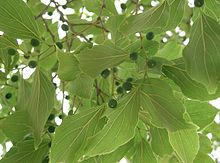Celtis
| Celtis | |
|---|---|

| |
| Leaves and immature fruit of Chinese hackberry (C. sinensis) | |
| Scientific classification | |
| Kingdom: | Plantae |
| Clade: | Tracheophytes |
| Clade: | Angiosperms |
| Clade: | Eudicots |
| Clade: | Rosids |
| Order: | Rosales |
| Family: | Cannabaceae |
| Genus: | Celtis L. |
| Species | |
|
Some 60–70 (see below) | |
| Synonyms | |
| |
Celtis is a
Description
Celtis species are generally medium-sized
Small flowers of this
The fruit is a small drupe 6–10 millimetres (1⁄4–3⁄8 in) in diameter, edible in many species, with a dryish but sweet, sugary consistency, reminiscent of a date.[citation needed]
Taxonomy
Previously included either in the elm family (Ulmaceae) or a separate family, Celtidaceae, the APG III system places Celtis in an expanded hemp family (Cannabaceae).[1][2]
Phylogeny
Members of the genus are present in the fossil record as early as the Miocene of Europe, and Paleocene of North America and eastern Asia.[3][4]
Species
66 species are currently accepted.[5]


- Celtis adolfi-friderici Engl. (western and central Africa)
- Celtis africana Burm.f. – white stinkwood (Afromontane region)
- Celtis australis L. – European hackberry, European nettle tree, or lote tree (Mediterranean Basin)
- Celtis balansae Planch. (New Caledonia, Australia)
- Celtis berteroana Urb. (Cuba, Hispaniola, Jamaica)
- Celtis bifida J.-F. Leroy (Madagascar)
- Celtis biondii Pamp.
- Celtis boninensis Koidz. (Japan – southwestern Honshu, western Kyushu, Ryukyu Islands, Ogasawara Islands)
- Celtis brasiliensis Planch.
- Celtis bungeana L. – Bunge's hackberry
- Celtis caucasica L. – Caucasian hackberry
- Celtis caudata Planch. (Mexico and Central America)
- Celtis cerasifera C.K.Schneid. (central and southern China, southeastern Tibet, and northern Myanmar)
- Celtis chekiangensis C.C.Cheng (China – Anhui and Zhejiang)
- Celtis chichape (Wedd.) Miq. (Bolivia, Paraguay, Uruguay, northern Argentina, and southern Brazil)
- Celtis conferta Planch. – cottonwood
- Celtis conferta subsp. conferta – New Caledonia
- Celtis conferta subsp. amblyphylla – Lord Howe Island
- Celtis ehrenbergiana (Klotzsch) Liebm. – spiny hackberry, granjeno (Spanish) (southern US, Mexico, Greater Antilles, northern South America)
- Celtis eriocarpa Decne.
- Celtis glabrata Steven ex Planch. (syn. Celtis planchoniana K.I.Chr.) (eastern Europe and western Asia)
- Celtis gomphophylla Baker (central and eastern Africa, Madagascar, Mayotte)
- Celtis harperi Horne ex Baker
- Celtis hildebrandii Soepadmo
- Celtis hypoleuca Planch. (New Caledonia, Australia)
- Celtis iguanaea (Jacq.) Sarg. – iguana hackberry (Florida (US), Mexico, Caribbean, Central and South America)
- Celtis jamaicensis Planch.
- Celtis jessoensis Koidz. – Japanese hackberry (Japan & Korea)
- Celtis julianae C.K.Schneid. – Julian hackberry China
- Celtis koraiensis L. – Korean hackberry
- Celtis labilis L. – Hubei hackberry
- Celtis laevigata Willd. – southern or sugar hackberry (southern US, Texas), sugarberry (eastern USA, northeastern Mexico)
- Celtis latifolia (Blume) Planch.
- Celtis lindheimeri Engelm. ex K.Koch – Lindheimer's hackberry (Texas (US), Coahuila (Mexico))
- Celtis loxensis C.C.Berg
- Celtis luzonica Warb. (Philippines)
- Celtis madagascariensis Sattarian (Madagascar)
- Celtis mauritiana Planch. (syn. Celtis prantlii Priemer ex Engl.) (tropical Africa and western Indian Ocean)
- Celtis mildbraedii Engl. (tropical Africa and Madagascar)
- Celtis neglecta Zi L.Chen & X.F.Jin
- Celtis occidentalis L. – common or northern hackberry, false elm (eastern North America)
- Celtis orthocanthos Planch.
- Celtis pacifica Planch.
- Celtis pallidaTorr. – desert or shiny hackberry (southwestern US / Texas, northern Mexico)
- Celtis paniculata (Endl.) Planch. – whitewood (eastern Malesia, eastern Australia, Micronesia, western Polynesia)
- Celtis petenensis Lundell
- Celtis philippensis Planch.
- Celtis punctata (Urb. & Ekman) Urb. & Ekman
- Celtis reticulata Torr. – netleaf hackberry (western North America)
- Celtis rigescens (Miq.) Planch.
- Celtis rubrovenia Elmer
- Celtis salomonensis Rech.
- Celtis schippii Standl.
- Celtis serratissima Zamengo, R.B.Torres, Gaglioti & Romaniuc
- Celtis sinensis Pers. – Chinese or Japanese hackberry, Chinese nettle tree (China and Japan)
- Celtis solenostigma Unwin
- Celtis spinosa Spreng.
- Celtis strychnoides Planch.
- Celtis tala Gillet ex Planch. – tala (South America)
- Celtis tenuifolia Nutt. – dwarf hackberry (North America)
- Celtis tessmannii Rendle. (central Africa)
- Celtis tetrandra Roxb. – Nilgiri elm
- Celtis tikalana Lundell
- Celtis timorensis Span. – kayu busok
- Celtis toka (Forssk.) Hepper & J. R. I. Wood (western, north-central, and northeastern Africa)
- Celtis tournefortii L. – Oriental hackberry
- Celtis trinervia Lam. – almex[6]
- Celtis vandervoetiana C.K.Schneid.
- Celtis vitiensis A.C.Sm.
- Celtis zenkeri Engl. (western, central, and eastern Africa)
Removed from genus
- Trema cannabina Lour. (as C. amboinensis Willd.)
- Trema lamarckiana(Schult.) Blume (as C. lamarckiana Schult.)
- Trema orientalis(L.) Blume (as C. guineensis Schumach. or C. orientalis L.)
Etymology
The generic name originated in Latin and was applied by Pliny the Elder to the unrelated Ziziphus lotus.[8]
Distribution and habitat
The trees are widespread in warm
Ecology
honeybees of lesser importance.
LepidopteraCeltis species are used as food plants by the brush-footed butterflies, most importantly the distinct genus Libythea (beak butterflies) and some Apaturinae (emperor butterflies):

PathogensThe basidiomycete fungus Perenniporia celtis was first described from a Celtis host plant. Some species of Celtis are threatened by habitat destruction .
Uses
Several species are grown as natural monuments of South Korea. The berries are generally edible when they ripen and fall.[14] C. occidentalis fruit was used by the Omaha, eaten casually, as well as the Dakota people, who pounded them fine, seeds and all. The Pawnee used the pounded fruits in combination with fat and parched corn.[15]
Hackberry wood is sometimes used in cabinetry and woodworking. The berries of some, such as Gallery
References
External links
|





